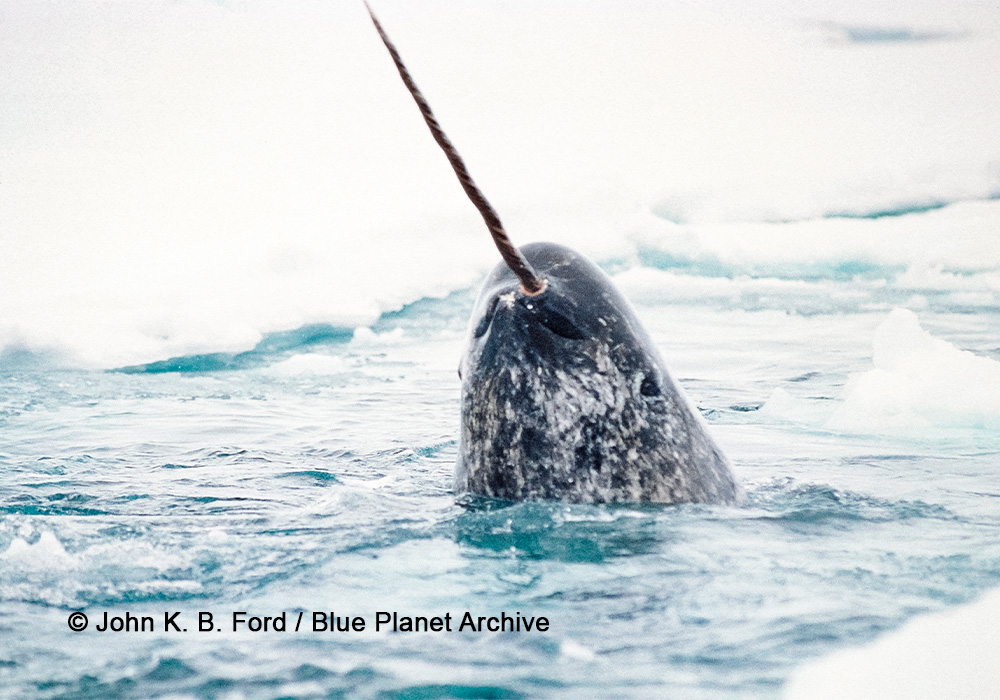
Melon-Headed Whale
January 13, 2025
Orca or Killer Whale
January 13, 2025 Narwhal – Tusked Whale of the Arctic
Narwhal – Tusked Whale of the Arctic
NARWHAL – Tusked Whale of the Arctic
Monodon monoceros
Linnaeus, 1758
DERIVATION: from the Greek monos for one-single, odon for tooth, and keros for horn.
One of the most fascinating and unusual creatures of the whale family is the arctic-dwelling whale with a tusk, the narwhal. An animal of legend and myth, the narwhal is undoubtedly the basis for the unicorn legend.
Narwhals are small whales (15-16 feet) distributed in the arctic waters of the northwestern Atlantic. The name of the marine mammal is frequently mispronounced as a narwhale. The proper pronunciation is nahr-wahl.
Their tusk is actually a tooth growing forward and through the upper lip, spiraling and tapering as it grows to a length of up to nine feet. Normally, the tusk is found on the left side of the male’s head. The purpose of the tusk has been the subject of much speculation from ice breaking and fish spearing to ornamentation. Narwhals have been observed stirring up sand on the ocean floor, but it is now believed that the primary use of the tusk is aggressive behavior by adult males.
Some scientists speculate that the tusks are used as jousting weapons. Males have been observed tapping them together in a ritualized manner. Researchers also attribute the scarring on adult male narwhal heads to sparring during mating season. Many old males have been noted with broken tusks; the broken shaft of one narwhal was found to contain the tusk of another whale.
During the Middle Ages, the narwhal tusk was believed to be unicorn horn. Since the unicorn was believed to render poison harmless, a drinking cup made from a narwhal tusk/unicorn horn was a very precious and expensive object.
Physical Characteristics:
The narwhal has no dorsal fin but instead a dorsal ridge. Color changes from bluish gray at birth to solid gray or black at adolescence. At maturity, white streaks and patches appear in the genital and navel areas spreading across the entire ventral surface.
Sexual Maturity: Females, 4-7 years; males 8-9 years. Females are believed to give birth every three years.
Diet: Fish, squid, octopus, shrimp and crabs.
Enemies: In addition to man, killer whales are narwhal natural enemies. Polar bears rarely prey on them, and sharks may attack weak or badly wounded animals. Narwhals were traditionally hunted by Eskimos for subsistence. Today, they are hunted for ivory and, to a lesser extent, for their skin and meat.
Another enemy is ice. Narwhals sense when ice leads are going to close and they leave the area. Unfortunately, sometimes they get trapped and perish when the ice closes and cuts off their air supply.
The narwhal habitat makes it a difficult whale to study, but population estimates are approximately 20,000. Overall, not much is known about this creature of myth and fantasy.
At present a potential threat to the narwhal habit is oil and gas exploration in Lancaster Sound. This sound, an area above Baffin Island, is teeming with marine and bird life. This ecosystem must be preserved if we are to learn more about the elusive narwhal.


